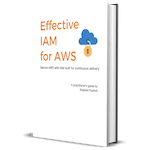Cloud Pattern: Secure Inbox
Let’s review a useful pattern for many cloud-hosted applications, the Secure Inbox. Use the Secure Inbox pattern to securely publish files of arbitrary size from one organization to another. We will implement this Secure Inbox implementation using the Amazon S3, KMS, and IAM services.

Figure: Secure Inbox
Problem: Organization A needs to publish a work product stored in potentially large files to a consumer in organization B. Organization A wants to maintain a high degree of control and ensure confidentiality of its data.
Operational Context: Operations in Amazon Web Services
Solution: Organization A generates the work product and stores it in an Outbox S3 bucket in its AWS account encrypted with a KMS encryption key owned by organization B. Organization A then copies the object from the outbox to a Secure Inbox S3 bucket in organization B’s account.
Examples:
- generate and deliver a nightly report
- transform and deliver a batch of images
- ad-hoc file deliveries between organizations
Description: The Secure Inbox pattern uses the AWS Simple Storage Service (S3) and Key Management Service (KMS) to store files generated by organization A and publish those files to organization B. Organization B maintains a high degree of control of this data by providing organization A with permission to use an encryption key that it controls. Azure and GCP offer similar object storage and encryption capabilities, so the pattern applies there after adjusting for API details.
Details
First, org A creates a outbox bucket and IAM roles and policies that permit:
- the
generatorto write to theoutboxbucket and encrypt objects using org B’s encryption key; notice that thegeneratorrole does not need to be able to decrypt data - the
publisherto copy objects in theoutboxbucket to other buckets usings3:CopyObject
Org B creates an inbox bucket and KMS encryption key, configures Bucket and KMS policies to permit org A to use those resources, and shares the ARNs of the bucket and key with org A.
Now org A generates data for org B.
When org A stores that data as an object in its outbox S3 bucket using the s3:PutObject API, it configures that API call to encrypt the object using org B’s key. If you’re using Python and the boto3 library, this looks like:
s3_client.put_object(ServerSideEncryption='aws:kms',
SSEKMSKeyId=kms_encryption_key_id,
Bucket=bucket_name,
Key=key,
Body=body_bytes)The generator needs an IAM policy that permits it to write to the outbox bucket using s3:PutObject. The IAM policy must also permit the kms:Encrypt and kms:GenerateDataKey APIs so that generator can use org B’s encryption key to encrypt the object. Notice that the generator role does not need to be able to decrypt data. This is a very useful security property, particularly if the generator runs in a dangerous execution context or you need to compartmentalize responsibilities.
Next, you’ll need to trigger the publishing process with the location of the object that was stored. This could be done via an SNS event, S3 event subscription, or some other mechanism.
When the publisher receives the notification that a new object was stored, it extracts the location of the newly stored object from the event and copies the object to organization B’s Secure Inbox. The publisher copies the object to the inbox bucket using the s3:CopyObject api action. The Python and boto3 code looks like:
s3_client.copy_object(CopySource=source,
Bucket=destination['Bucket'],
Key=destination['Key'],
MetadataDirective='REPLACE',
ServerSideEncryption='aws:kms',
SSEKMSKeyId=destination['SSEKMSKeyId'])The copy_object method call is more interesting than the put. This request copies objects across accounts and there are few things that may hang you up.
SSEKMSKeyIdmust be set to the full ARN of organization B’s encryption key so that it resolves properly- The
publisher‘s IAM role must have permission to callkms:Decryptso that S3 can read the currently encrypted data, generate a new data key withkms:GenerateDataKey*, and finallykms:Encryptthe data on thepublisher‘s behalf - Notably, the key policy for org B’s encryption key, must also permit the
publisherrole tokms:Decrypt,kms:GenerateDataKey*, andkms:Encryptwith the key. However, thepublisherrole never actually sees the data in this case because the decryption and encryption process is handled server-side by S3 as part ofs3:CopyObject
Results
With the Secure Inbox pattern:
- Organization A can store and deliver objects of arbitrary size to partners while narrowly scoping what partner data its own teams and applications have access to
- Organization B can receive work generated by partners reliably and securely while maintaining tight control over who has access to that data via KMS encryption key policy and bucket policy
Contact Us
Please contact us with questions or comments. We’d love to discuss AWS security with you.
Effective IAM for AWS

Learn how to secure AWS with IAM built for continuous delivery.
